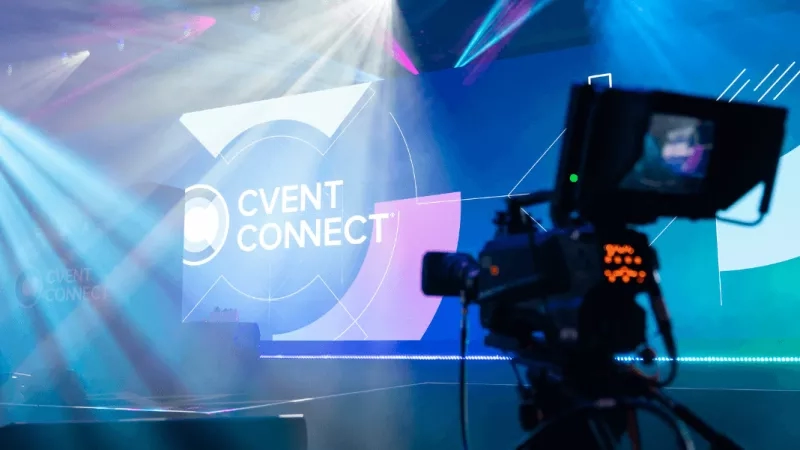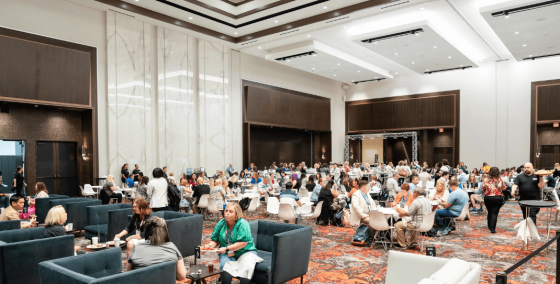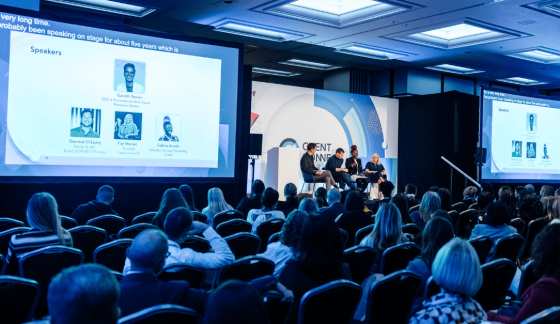A user conference is an event where a company brings together its customers to learn, network, and share experiences. These conferences educate attendees on product updates, foster community, and provide direct access to company experts. Benefits include increased product adoption and customer engagement.
Cvent CONNECT. Dreamforce. WWDC. Adobe Summit.
People pack their bags and show up (and attend virtually) to these events every year for one reason: they want to leave knowing more than when they came in.
And that’s the whole point of a user conference. You bring together customers, prospects, partners, sponsors, and more so they can learn what’s new, exchange ideas, and leave with something they can use.
When you plan one yourself, you need to ensure the whole experience feels useful: the right sessions, the right speakers, and plenty of time for face-to-face conversations. In this guide, we’ll break down what goes into planning a successful one based on what we do at our annual conference, Cvent CONNECT.
What are user conferences?
A user conference, including CX conferences or customer support conventions, is an event a company hosts for its customers.
People come because they want to see what’s new, get training, and meet the team that built the products they use every day. Some companies run them as small, hands‑on workshops. Others go big with keynotes, demos, and full breakout schedules.
No matter the size, the idea stays the same: give customers a place to learn, ask questions, and leave with a few new skills they can put to work as soon as they return.
3 examples of successful user conferences
Cvent CONNECT
Cvent CONNECT is our annual flagship event. This year, we held it both in San Antonio and online. Approximately 3,900 event planners and hospitality professionals attended in person, while thousands more participated virtually.
Our hybrid conference typically includes product roadmaps, customer training, breakout sessions, several keynotes, executive meetings, networking sessions, a trade show, vendor showcases, themed nights out, entertainment, and wellness activities (this year, we had puppy yoga, kitten and baby goat meet-ups, and baby donkeys, all to give attendees a much-needed endorphin rush).
Our Innovation Pavilion offers attendees the chance to get hands-on with our event technology and experience several fun activations..
If someone attends virtually, they still get a unique, curated, personalized experience. They can jump into a conference networking session, virtual-only programming on Cvent CONNECT TV, book one‑on‑one appointments, and move between sessions without feeling like they missed what was happening in the hallways. Additionally, they can view anything they may have missed or want to see on-demand via the Cvent Attendee Hub.
And we take Cvent CONNECT global, too.
Cvent CONNECT Europe takes place in the fall, in London. It mimics the North American structure—keynotes, labs, and exhibit halls—but adapts session times and content for European attendees and their particular needs and interests. It brings together the same mix of live and virtual guests, focused on regional trends and connections.
Dreamforce
Dreamforce runs annually in San Francisco, typically in mid-October. With over 40,000 attendees joining in person and around 200,000 participating online via Salesforce+, Dreamforce seemingly turns San Francisco’s entire downtown into Salesforce a campus for a few days.
There’s a long list of sessions and hands‑on training if you want to learn something new. Dreamforce offers over 1,500 sessions, more than 115 speakers, and over 11,000 product experts onsite.
Salesforce uses different conference themes to attract different customers. Some might want to catch up on the product roadmap, while others might want to hear from companies pushing the platform to new places and trade ideas with people they’d never meet otherwise.
That’s what most people remember: those one‑off conversations between sessions or at the big Dreamfest concert that ends the week. That mix of big spectacle and practical, hands-on learning is what makes Dreamforce a hit.
Adobe Summit
Adobe Summit is a large-scale conference by software giant Adobe. This year, it took place from March 18 to 20 in Las Vegas and online. Adobe Summit drew over 11,000 in-person attendees from more than 70 countries, with nearly twice that joining virtually.
Attendees typically spend a day before the main event in pre-conference labs and training sessions. Then, the main days feature keynotes, “Sneaks,” hands-on certification, community zones, and strategy sessions, totaling approximately 200 sessions.
The focus of Adobe Summit is on real skills. Labs walk attendees through AI workflows, analytics, and marketing tools. The objective is to give people ideas they can take back to work and put to use immediately.
Evenings mean networking at lounges or casual video demos.
Attendees leave this customer experience conference knowing exactly which feature they’ll test next, what idea to push to their leadership, and what new tricks peers are using. And that’s the whole point of it.
15 tips on how to plan a successful user conference
Before the event
1. Get clear on why you’re doing it
Our event planning experience tells us that before you pick a date or send a single invite, nail down the reason you’re hosting a user conference. That reason guides every other decision.
Some years, you’ll focus on hands‑on training. In other years, you’ll use the stage to share what’s next for your product or the industry. If you skip this part, you might end up making choices that don’t fit together, and your customers can feel that.
2. Set a realistic budget
Your budget shapes the entire conference experience. Work out the big items upfront, such as the venue, tech, speakers, AV, and catering. Then, add the smaller stuff, like shipping and signage.
And leave some room for surprises. If you wait until the last minute to sort this out, you’ll end up making rushed compromises you don’t want.
3. Pick dates and a venue early
Your customers have their schedules. Pick a date that doesn’t clash with holidays or major industry events they’re already attending. And book the venue long before you need it.
When we plan CONNECT, we lock in dates nearly a year out. That way, we can give everyone enough notice and avoid awkward conflicts.
4. Build an agenda that feels real
Once you know what you want to do and where you’ll do it, you can focus on the sessions.
The most memorable conferences don’t feel like product pitches.
They give customers real stories and practical lessons. That’s why most sessions at Cvent CONNECT are led by customers--they talk about the work they’re doing, not just slides someone handed them. That kind of conference agenda takes time to put together. You can’t wait until the last minute and hope it all falls into place.
5. Confirm speakers and formats early
Your speakers and formats matter more than most people realize. Labs, hands‑on training, small group Q&As, and keynotes each suit a different kind of learning.
When we plan Cvent CONNECT, we first consider the balance of session types, and then we invite the people who can make them a reality. That way, you’re not forcing someone into a format that doesn’t fit them or the audience.
6. Get registration and promotion moving
You want people to plan their trip before their calendars fill up. That’s why we open registration at least four to six months before the event.
Always promote in waves, early bird offers, agenda previews, and speaker profiles, so there’s always a reason to take a second look.
We use our event management software to do that, so it automates most of the pre-registration work and gives people time to plan travel and a reason to put our event on their schedule.
During the conference
7. Test every bit of tech
The last thing you want is a microphone going dead right before a keynote. Test everything before the event and don’t leave anything to chance.
Check every part of the setup, badge printers, slide clickers, livestreams, a few days before. And you give every speaker a short practice run with the AV team so they’re not seeing the room for the first time when they walk on stage.
8. Make it easy to get around
That first hour feels busy, with people juggling bags, checking their phones, and looking around for where to go. That’s the moment a helpful face or a clear sign proves invaluable. Post staff at entrances, by the elevators, and outside breakout rooms so that nobody is left wandering. And check in with your team every morning so everyone knows about last‑minute changes, if there are any.
9. Give attendees space to connect
Nobody wants to spend all day racing between sessions. Long breaks and casual spots with tables, coffee, and places to plug in a laptop provide people with a reason to stick around and chat. That’s often where they make the connections they’ll remember long after they leave.
10. Have a backup ready
Plans never go perfectly. Someone’s flight is late, a projector dies, or a speaker bails at the last minute. When you assume something will go wrong, you can plan for it. Perhaps you can move a speaker to video or switch the session to a Q&A format. When you do that calmly, most people never even notice.
11. Help them share the moment
You want the event to live beyond the ballroom walls.
That means ensuring quality, providing free Wi-Fi, ensuring photographers catch the best shots, and recording every session. When all those pieces come together, people naturally post, tag, and talk about what they’re seeing, and nobody’s left wondering what they missed.
After the conference
12. Get resources into their hands before they forget
The event might be over, but your job isn’t. People walk away with a bunch of ideas they want to put into action, and they need those session recordings and slides while they still care.
That’s why you don’t wait. Have those assets ready to go and send them quickly, even if it’s just a simple page with links. When you make it easy for people to catch up on what they missed, they see you as a real partner, not just someone who invited them to a big party.
13. Listen to what attendees tell you
By the time everyone’s left your event, they already have a good idea about what they liked and what didn’t hit.
Strike while the iron is hot and prep the post-event survey to drop when your attendees are leaving the venue. If you wait too long to send it, chances are everyone will have already moved on.
Keep the survey itself manageable and the questions short. The last thing an attendee wants is a daunting survey that's a chore to complete. This leads to drop-offs and abandonments and can be frustrating, leaving a bad taste in the mouth. When you read those responses early, you catch real details that won’t come up if you wait too long. Use this feedback in your post-con and share it with key individuals on your greater team.
14. Sit down with your team
When the crowds are gone and the hallways are empty, take an hour with your team to reflect, blow off steam, and have honest conversations about areas of improvement while they're fresh in everyone's minds.
Skip the slides, and don’t make this a stiff, formal meeting. Go over what went well, what felt off, and what you’d do differently next time. You’ll catch things in this kind of casual debrief that you’d never see on a spreadsheet.
15. Stay in touch
You spent months putting this together. Don’t let the energy fade once everyone goes home.
Check in with people a couple of weeks after the event. Share on-demand content, recaps, and other valuable session and product information tailored to each particular audience.
Offer them a demo. Host a quick Q&A session or an AMA. When you do this, they don’t feel like the conference was a one-time thing. Instead, they feel like they’re part of an ongoing conversation.
Wrapping it up
Conference management takes a lot of work, and user conferences are not something you put together on autopilot.
People come because they want something they can use, an idea they can try, a contact they can reach out to, or a new feature they understand better.
That’s why these events matter. In fact,19.5% of planners expect at least 1,000 people at their in‑person events next year.
And when you do it right, they’ll come back.
Frequently asked questions
What are examples of user events?
User events can be hands-on conferences where companies bring customers together. Some companies hold product-specific conferences, while others host user groups or training summits. Big names like Cvent CONNECT, Dreamforce, and Adobe Summit draw thousands of customers who come to learn, try new tools, and trade ideas.
How do you plan a user conference?
You plan a user conference by starting with an apparent reason for hosting it. Then, you pick dates and a venue that work for your audience. After that, you shape an agenda around what your customers care about most. Finally, you run through logistics, such as registration, tech checks, and speaker preparation, and ensure everyone knows what to do onsite.
Who attends user conferences?
User conferences attract the people who use your product. That could mean hands-on practitioners, managers, decision-makers, or partners. You’ll also see your team members, guest speakers, sponsors, and people interested in what you do.









